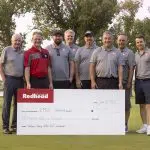
Bovine AI: Alberta cattle rancher says technology helps save time and money
Ashley Perepelkin says she was born and raised a city girl, never thinking she’d sell fresh beef from cattle she raised on her own Alberta farm with the help of artificial intelligence.
“I met a boy, and this boy happened to be a farmer,” she says.
Perepelkin, who spent most of her life in Red Deer, Alta., says she and her now-husband Andrew met in 2010, got married and began farming grain together.
When she decided to get cattle, it was a steep learning curve.


